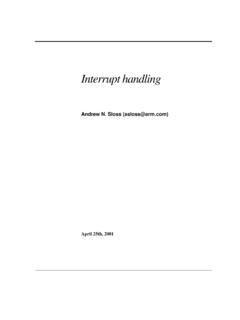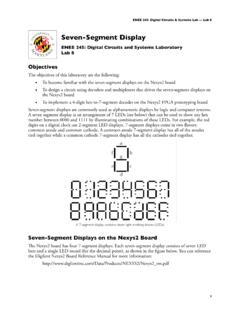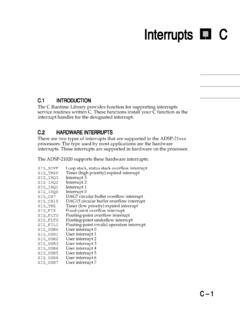Transcription of Exception and Interrupt Handling in ARM
1 Exception and Interrupt Handling in ARM Architectures and Design Methods for Embedded Systems Summer Semester 2006 Author: Ahmed Fathy Mohammed Abdelrazek Advisor: Dominik L cke Abstract We discuss exceptions and Interrupt Handling techniques in ARM processors and see how the ARM architecture works in this area to know how are these techniques suitable for embedded systems to achieve the time constraints and safety requirements. Exception and Interrupt Handling is a critical issue since it affect directly the speed of the system and how fast does the system respond to external events and how does it deal with more than one external event at the same time by assigning priorities to these events.
2 Table of contents Abstract .. 2 Table of contents .. 2 List of Figures .. 3 Abbreviations .. 3 1 Introduction .. 4 ARM modes of operation .. 4 ARM Register 5 .. 6 2 ARM Exceptions ..6 Vector Table .. 7 Exception priorities .. 8 Link Register 8 Entering and exiting an Exception 9 3 interrupts .. 9 How are interrupts assigned? .. 9 Interrupt 10 IRQ and FIQ exceptions .. 10 Interrupt stack .. 10 4 Interrupt Handling schemes .. 11 Non-nested Interrupt Handling .. 11 Non-nested Interrupt Handling summery:.. 12 Nested Interrupt 12 Nested Interrupt Handling summery.
3 13 Prioritized simple Interrupt Handling .. 13 Prioritized simple Interrupt Handling summery:.. 14 Other schemes .. 15 5 Final 16 Which Interrupt Handling scheme to use? .. 16 References .. 17 List of Figures Figure 1: Register Organization in ARM [5].. 6 Figure 2 An exact vector table with the branching instruction[5].. 7 Figure 3 Typical Memory 11 Figure 4 Simple non nested Interrupt 12 Figure 5 Nested Interrupt Handling .. 13 Figure 6 Priority Interrupt Handler [1].. 14 Abbreviations ISR Interrupt Service Routine SWI Software Interrupt IRQ Interrupt Request FIQ Fast Interrupt Request ARM Advanced RISC Machines RISC Reduced Instruction Set Computers SVC Supervisor CPSR Current Program Status Register SPSR Saved Program Status Register LDR Load Register STR Store Register DMA Direct Memory Access 1 Introduction Exceptions are so important in embedded systems, without Exception the development of systems would be a very complex task.
4 With exceptions we can detect bugs in the application, errors in memory access and finally debug it by placing breakpoints and building the program with debugging information. interrupts which are kinds of exceptions are essential in embedded systems. It enables the system to deal with external events by receiving Interrupt signals telling the CPU that there is something to be done instead of the alternative way of doing the same operation by the pooling mechanism which wastes the CPU time in looping forever checking some flags to know that the event occurred. Due to the fact that systems are going more complex day after day, we have nowadays systems with more than one Interrupt source. That is why an Interrupt Handling scheme is needed to define how different cases will be handled.
5 We may need priorities to be assigned to different interrupts and in some other cases we may need nested Handling capabilities. We introduce the ARM processor itself to see its different modes of operation and then we have an overview of the register set. This is because dealing with interrupts and exceptions causes the ARM core to switch between these modes and copy some of the registers into other registers to safe the core state before switching to the new mode. In the next chapter we introduce exceptions and see how the ARM processor handles exceptions. In the third chapter we define interrupts and discuss mechanisms of Interrupt Handling on ARM. In the forth chapter we provide a set of standard Interrupt Handling schemes.
6 And finally some remarks regarding these schemes and which one is suitable to which application. The main source of information provided in this paper is mainly the book ARM System Developer s Guide [1]. ARM modes of operation The ARM processor internally has 7 different modes of operation, they are as follows; User mode: It is used for normal program execution state, FIQ mode: This mode is used for interrupts requiring fast response and low latency like for example data transfer with DMA, IRQ mode: This mode is used for general Interrupt services, Supervisor mode: This mode is used when operating system support is needed where it works as protected mode, Abort mode: selected when data or instruction fetch is aborted, system mode: Operating system privilege mode for users and undefined mode: When undefined instruction is fetched.
7 The following table summarizes the 7 modes: Processor Mode Description User (usr) Normal program execution mode FIQ (fiq) Fast data processing mode IRQ (irq) For general purpose interrupts Supervisor (svc) A protected mode for the operating system Abort (abt) When data or instruction fetch is aborted Undefined (und) For undefined instructions System (sys) Operating system privileged mode ARM Register set Register structure in ARM depends on the mode of operation. For example we have 16 (32-bit) registers named from R0 to R15 in ARM mode (usr). Registers R0 to R12 are general purpose registers, R13 is stack pointer (SP), R14 is subroutine link register and R15 is program counter (PC). R16 is the current program status register (CPSR) this register is shared between all modes and it is used by the ARM core all the time and it plays a main role in the process of switching between modes.
8 In other modes some of these 16 registers are visible and can be accessed and some others are not visible and can t be accessed. Also some registers are available with the same name but as another physical register in memory which is called (banked), existence of such banked registers decreases the effort needed when context switching is required since the new mode has its own physical register space and no need to store the old mode s register values. So in ARM7 we have a total of 37 physical registers and the following figure shows the ARM7 register set. Figure 1: Register Organization in ARM [5] As we can see the banked registers are marked with the gray colour. We can notice that in the FIQ mode there are more banked registers, this is to speed up the context switching since there will be no need to store many registers when switching to the FIQ mode.
9 We may need only to store the values of registers r0 to r7 if the FIQ handler needs to use those registers, but registers r8_fiq to r14_fiq are specific registers for the FIQ mode and can t be accesses by any other mode (they become invisible in other modes). 2 ARM Exceptions An Exception is any condition that needs to halt normal execution of the instructions [1]. As an example of exceptions the state of resetting ARM core, the failure of fetching instructions or memory access, when an external Interrupt is raised or when a software Interrupt instruction is executed. There is always software associated with each Exception , this software is called Exception handler. Each of the ARM exceptions causes the ARM core to enter a certain mode automatically also we can switch between different modes manually by modifying the CPSR register.
10 The following table summarises different exceptions and the associated mode of operation on ARM processor. Exception Mode Fast Interrupt Request FIQ Interrupt Request IRQ SWI and RESET SVC Instruction fetch or memory access failure ABT Undefined Instruction UND More banked registers, so context switching is faster Vector Table It is a table of instructions that the ARM core branches to when an Exception is raised. These instructions are places in a specific part in memory and its address is related to the Exception type. It always contains a branching instruction in one of the following forms: B <Add> This instruction is used to make branching to the memory location with address Add relative to the current location of the pc.














